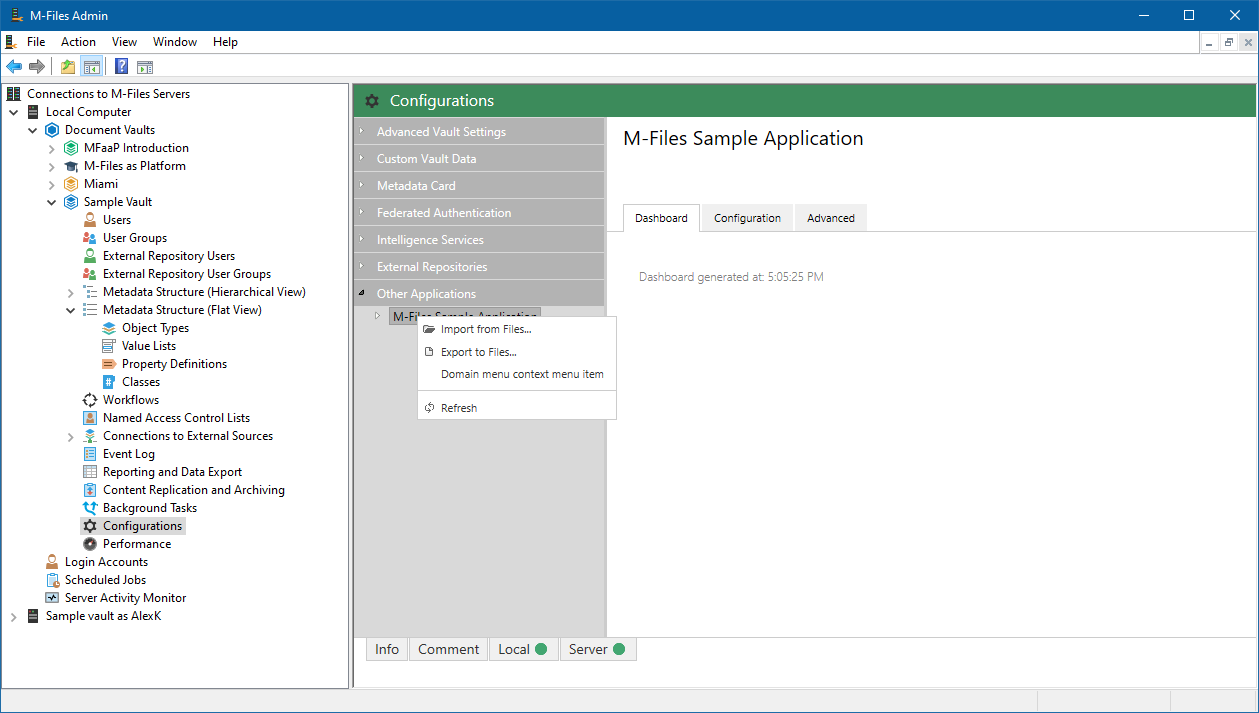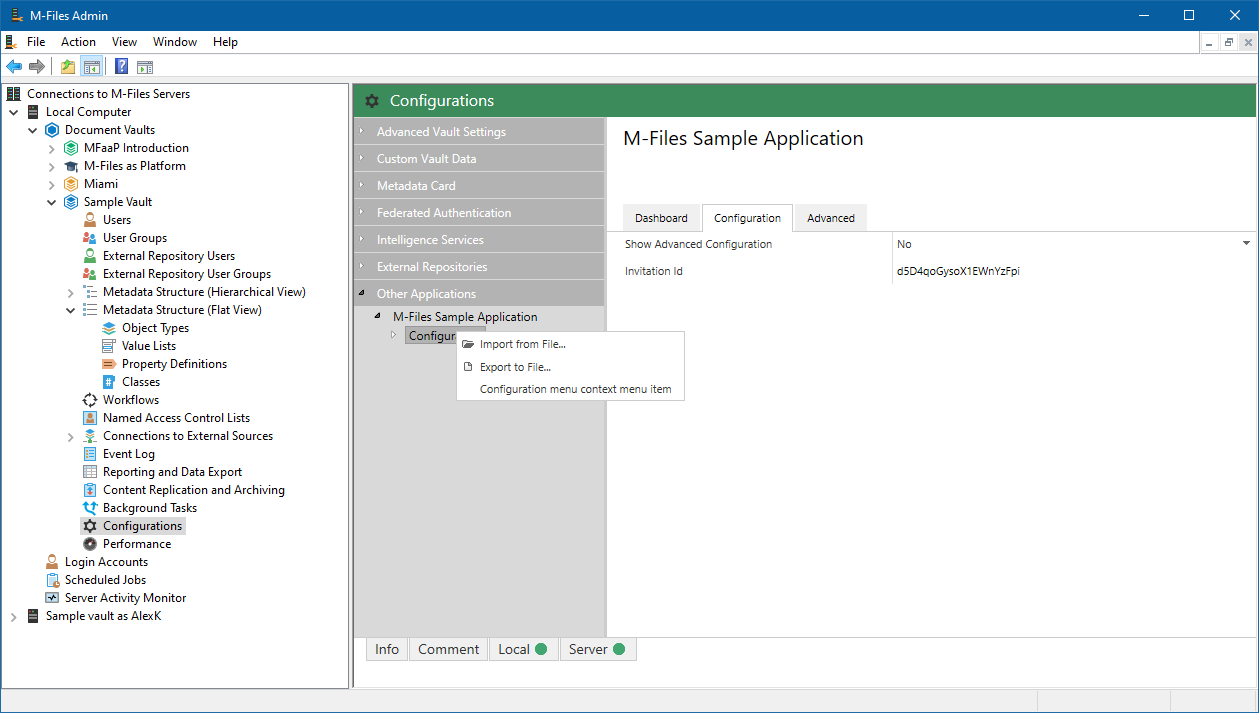Commands
Compatibility
The content of this page can only be used if the following condition(s) are all met:
- You must target the Vault Application Framework 2.1 or higher.
Commands are used to define a server-side function that can be executed from within the M-Files Admin configuration section. Commands are typically then shown within the configuration area header, the domain menu, the configuration menu, or within custom dashboards. This page focuses on command usage outside of custom dashboards.
To create a custom command, you must
- Declare the
CustomDomainCommand. The command must include:- A unique ID for the command.
- The code to execute when the command is run.
- The text to display on the button or context-menu item.
- The location(s) where the command should be shown.
- Ensure that the command is returned by
GetCommands.
Displaying commands in the header
To display a button in the header of the configuration area, set the Locations property to include an instance of the ButtonBarCommandLocation class:
/// <summary>
/// Appears at the top of the configuration page.
/// </summary>
private readonly CustomDomainCommand cmdHeaderButtonCommand = new CustomDomainCommand
{
ID = "cmdHeaderButtonCommand",
Execute = (c, o) =>
{
o.ShowMessage("Header button");
},
DisplayName = "Header button",
Locations = new List<ICommandLocation>
{
new ButtonBarCommandLocation()
}
};
/// <inheritdoc />
public override IEnumerable<CustomDomainCommand> GetCommands(IConfigurationRequestContext context)
{
return new List<CustomDomainCommand>(base.GetCommands(context))
{
this.cmdHeaderButtonCommand,
};
}

Displaying context menu items for the domain menu
The domain menu item is the menu item added to the “Other Applications” area in the M-Files Admin Configurations screen. It is typically the item that displays the name of your vault application, such as M-Files Sample Application in the screenshot below. Adding a context menu item here will be displayed when the user right-clicks on this item.
To display a context menu item under the domain menu item, set the Locations property to include an instance of the DomainMenuCommandLocation class:
/// <summary>
/// Appears when right-clicking on the application node in the Configurations area.
/// </summary>
private readonly CustomDomainCommand cmdDomainMenuContextMenuItem = new CustomDomainCommand
{
ID = "cmdDomainMenuContextMenuItem",
Execute = (c, o) =>
{
o.ShowMessage("Domain menu context menu item");
},
DisplayName = "Domain menu context menu item",
Locations = new List<ICommandLocation>
{
new DomainMenuCommandLocation()
}
};
/// <inheritdoc />
public override IEnumerable<CustomDomainCommand> GetCommands(IConfigurationRequestContext context)
{
return new List<CustomDomainCommand>(base.GetCommands(context))
{
this.cmdDomainMenuContextMenuItem,
};
}

Displaying context menu items for the configuration menu
The domain menu item is the menu item named “Configuration” that is automatically added under your domain node. Adding a context menu item here will be displayed when the user right-clicks on “Configuration”.
To display a context menu item under the domain menu item, set the Locations property to include an instance of the DomainMenuCommandLocation class:
/// <summary>
/// Appears when right-clicking on the configuration node in the Configurations area.
/// </summary>
private readonly CustomDomainCommand cmdConfigurationMenuContextMenuItem = new CustomDomainCommand
{
ID = nameof(VaultApplication.cmdConfigurationMenuContextMenuItem),
Execute = (c, o) =>
{
o.ShowMessage("Configuration menu context menu item");
},
DisplayName = "Configuration menu context menu item",
Locations = new List<ICommandLocation>
{
new ConfigurationMenuCommandLocation()
}
};
/// <inheritdoc />
public override IEnumerable<CustomDomainCommand> GetCommands(IConfigurationRequestContext context)
{
return new List<CustomDomainCommand>(base.GetCommands(context))
{
this.cmdConfigurationMenuContextMenuItem,
};
}

Command icons
Commands shown in the domain and configuration context menus can optionally have an icon set. The icon can be any icon in the jQuery UI icons library. To set an icon, provide the appropriate string when setting the command location. The string should be the name of the icon in jQuery UI with the ui-icon- prefix removed; for example to use the ui-icon-shuffle icon the string should be shuffle:
/// <summary>
/// Appears when right-clicking on the application node in the Configurations area.
/// </summary>
private readonly CustomDomainCommand cmdShuffleMenuItem = new CustomDomainCommand
{
ID = "cmdShuffleMenuItem",
Execute = (c, o) =>
{
// TODO: Shuffle something.
},
DisplayName = "Shuffle",
Locations = new List<ICommandLocation>
{
new DomainMenuCommandLocation(icon: "shuffle")
}
};
/// <inheritdoc />
public override IEnumerable<CustomDomainCommand> GetCommands(IConfigurationRequestContext context)
{
return new List<CustomDomainCommand>(base.GetCommands(context))
{
this.cmdShuffleMenuItem,
};
}
![]()